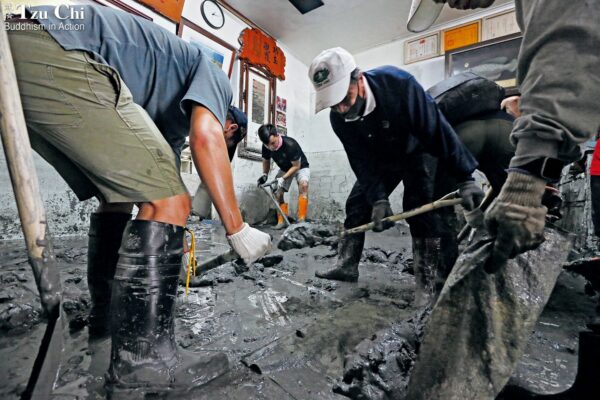By Hong Jing-jing
Translated by Wu Hsiao-ting
Photos by Yan Lin-zhao
The Anti-Aging Fitness Center at Chiayi Tzu Chi Clinic combines healthcare and fitness in their strength training regimens, designed to prevent functional impairments, delay aging, and help people live with quality and confidence.
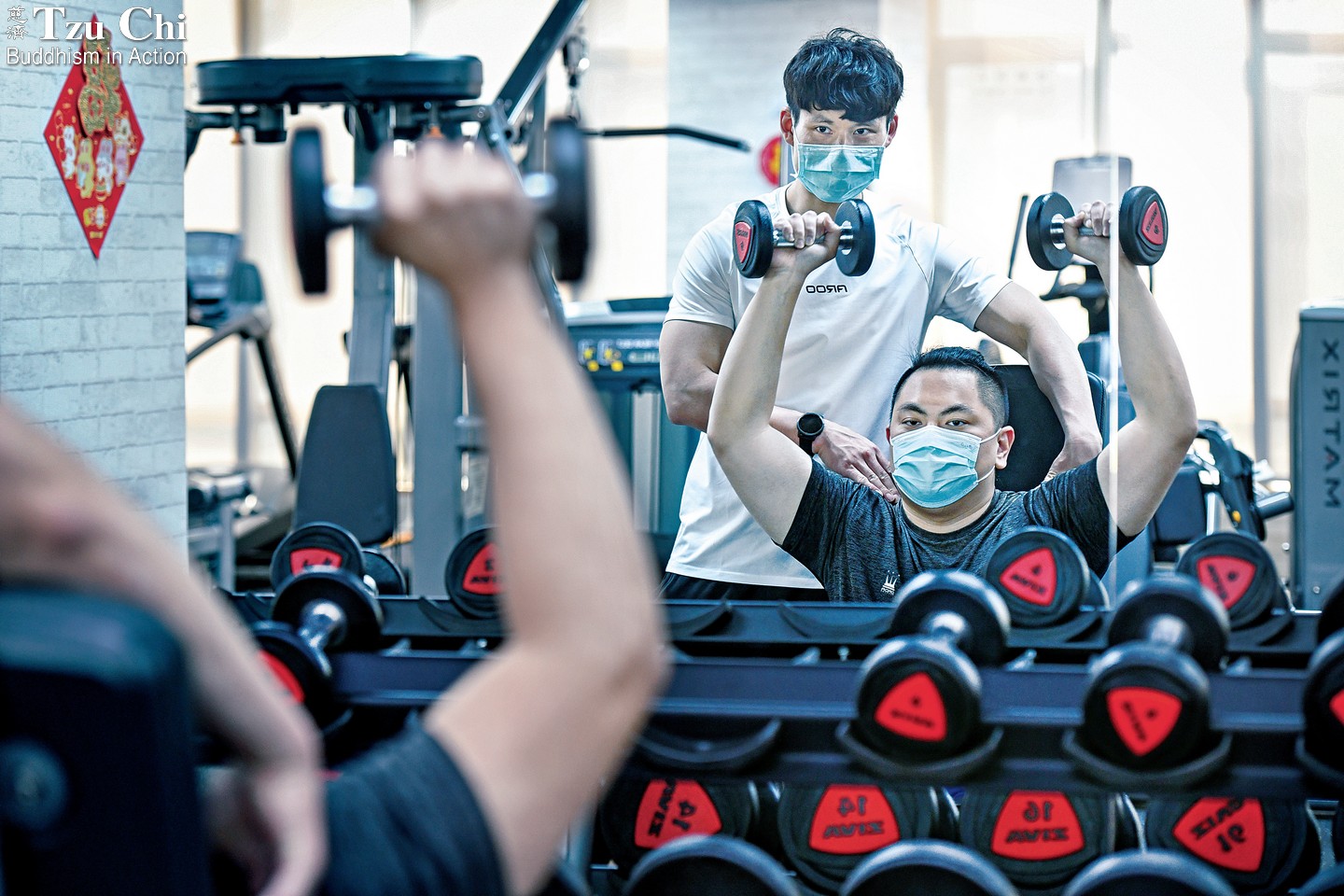
A man does strength exercises under the guidance of a trainer at the Anti-Aging Fitness Center at Chiayi Tzu Chi Clinic, southern Taiwan. The center is devoted to the prevention of sarcopenia and functional disabilities.
What type of people do you expect to see in a fitness center? Younger persons, exercising vigorously to slim down or stay fit, their faces and bodies covered in sweat? If that’s what you imagine, the Anti-Aging Fitness Center at Chiayi Tzu Chi Clinic in southern Taiwan will surely upend your stereotypes.
Here’s a couple of examples of the type of person you will see at this fitness center: an 80-year-old woman suffering from osteoporosis and an 82-year-old retired doctor. After the elderly woman started strength training at the fitness center, a body composition analysis showed an increase in her muscle mass as well as a reduction in her body fat. And the man, who had never been exposed to weight training before, can now do a barbell back squat and other free weight training. He enjoyed strength training so much he said, “Strength training has improved my quality of life after retirement. I wish I had started earlier!”
The Anti-Aging Fitness Center, opened in April 2022, is a joint effort of Dalin Tzu Chi Hospital and Chiayi Tzu Chi Clinic. Merging healthcare and fitness, the center offers one-on-one strength training services, mainly to patients at the clinic.
Taiwan is projected to become a super-aged society by 2025, with people 65 or older making up at least 20 percent of the population. Dr. Chou Yi-chun (周宜群), director of the Anti-Aging Fitness Center, pointed out that old age is often accompanied by sarcopenia—the gradual loss of muscle mass and strength—as well as degenerative bone and nervous system conditions. Once the degeneration starts, functional impairments follow, negatively affecting one’s quality of life.
Cardiovascular exercises, such as brisk walking, running, or bicycling, can only do so much when it comes to building muscle strength. “You need stimulation from weight training if you want your muscle strength to grow,” said Director Chou. Only when your training is providing enough stimuli to your muscles, bones, and nervous system will you achieve muscle growth. Since the main goal of the fitness center is to promote strength training to prevent or reverse functional disabilities, exercise prescriptions are tailored to the clinical context of each patient. This helps them recover or improve their quality of life.
The more you work them
“Everyone should treat their body well,” said Director Chou. “You can’t rely on intravenous injections, medications, or health supplements [to achieve wellness]. The key to that is actually good dietary and exercise habits.” In addition to being at the helm of the fitness center, Chou, 40, also works at Dalin Tzu Chi Hospital as a gastroenterologist and a liver cancer expert. Growing up, he was overweight and suffered from asthma and allergies. He was often on medication. He started exercising regularly by jogging and playing basketball to improve his health when he was in junior high school. Later, as a resident doctor, he wanted to get in even better physical shape. He surfed the web for tutorial videos on weight training and began training on his own.
Five years ago, he enrolled in a gym and started working out under the instruction of a professional trainer. He was encouraged by his improved body shape after training at the gym, and began to wonder if weight training could improve one’s health in other ways. He had once suffered from gout himself, which prompted him to begin studying in earnest the benefits of weight training. He even sat for and passed the American Council on Exercise Personal Trainer Exam and obtained his certification as a trainer. “My body is now in the best shape ever,” he said.
Strength or resistance training can improve an older person’s posture and balance. Practicing standing on one foot alone can’t improve one’s balance. Chou said that there is a built-in balance system in our muscles. When a person strength trains, they use every muscle in their body, including their core muscles. Core strength is especially important for balance “because you need good stability at your core to have safe and effective movement at the hip, knee, and ankle,” says Kailin Collins, a physical therapist at Harvard-affiliated Massachusetts General Hospital.
Some seniors tend to fall on unstable surfaces or uneven ground. “Strength training can help ensure that one has enough muscle strength or quick enough nervous reflexes to regain one’s balance and prevent oneself from falling,” Chou explained.
Lin Xiu-yue (林秀月), 68, has been a Tzu Chi recycling volunteer for 30 years. One time when she was transporting a full load of recyclables on her scooter, she lost her balance and fell with the scooter. Her weak right leg was partly to blame for the accident. The muscles in her right leg had atrophied due to polio, and her right knee had degenerated to such a point that she couldn’t even have a knee replacement. She couldn’t sit for long and had difficulty remaining steady when she stood up from a sitting position. At the recommendation of Director Chou, she started visiting the fitness center to build her muscles.
Lin’s personal trainer at the fitness center put an emphasis on helping her right leg become stronger. For example, the trainer would have her sit on a chair, with pads under her right buttock to keep it higher. This was to prevent her from getting injured, because the atrophied muscles in her right side had resulted in one of her hips being higher than the other. Then Lin would straighten her right leg, have a resistance band wrapped round her ankle, and, with her trainer serving as the resistance, try to kick her leg upwards. She would do ten such kicks in a row. Lin used to depend on medicine and injections for treatment to her right leg, and it never occurred to her that her right leg could become stronger. But after training at the center, she felt an obvious increase of strength in both her arms and legs. “I’m proud of myself,” she said. “Now when I ride out in a truck to collect recyclables, I can easily toss bag after bag of recycling onto the truck. Despite my age, I’m stronger than before. I’ll keep training so that I can do more recycling work.”
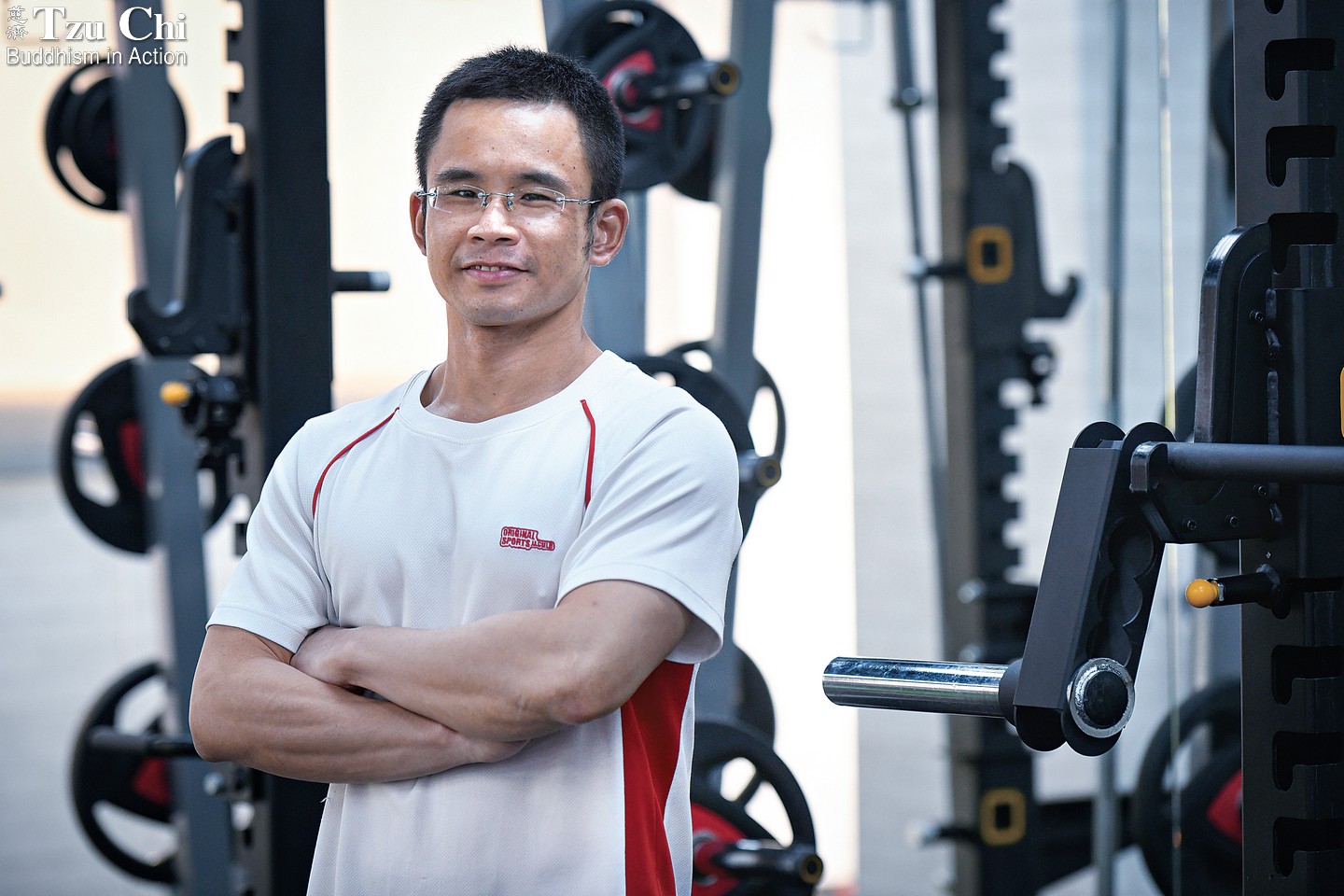
Dr. Chou Yi-chun, director of the Anti-Aging Fitness Center, hopes to use fitness training to help improve people’s quality of life.
Dr. Chou has made himself healthier by maintaining his exercise habits. He recommends that people build up their muscles via strength training to prevent the loss of muscle mass and strength.
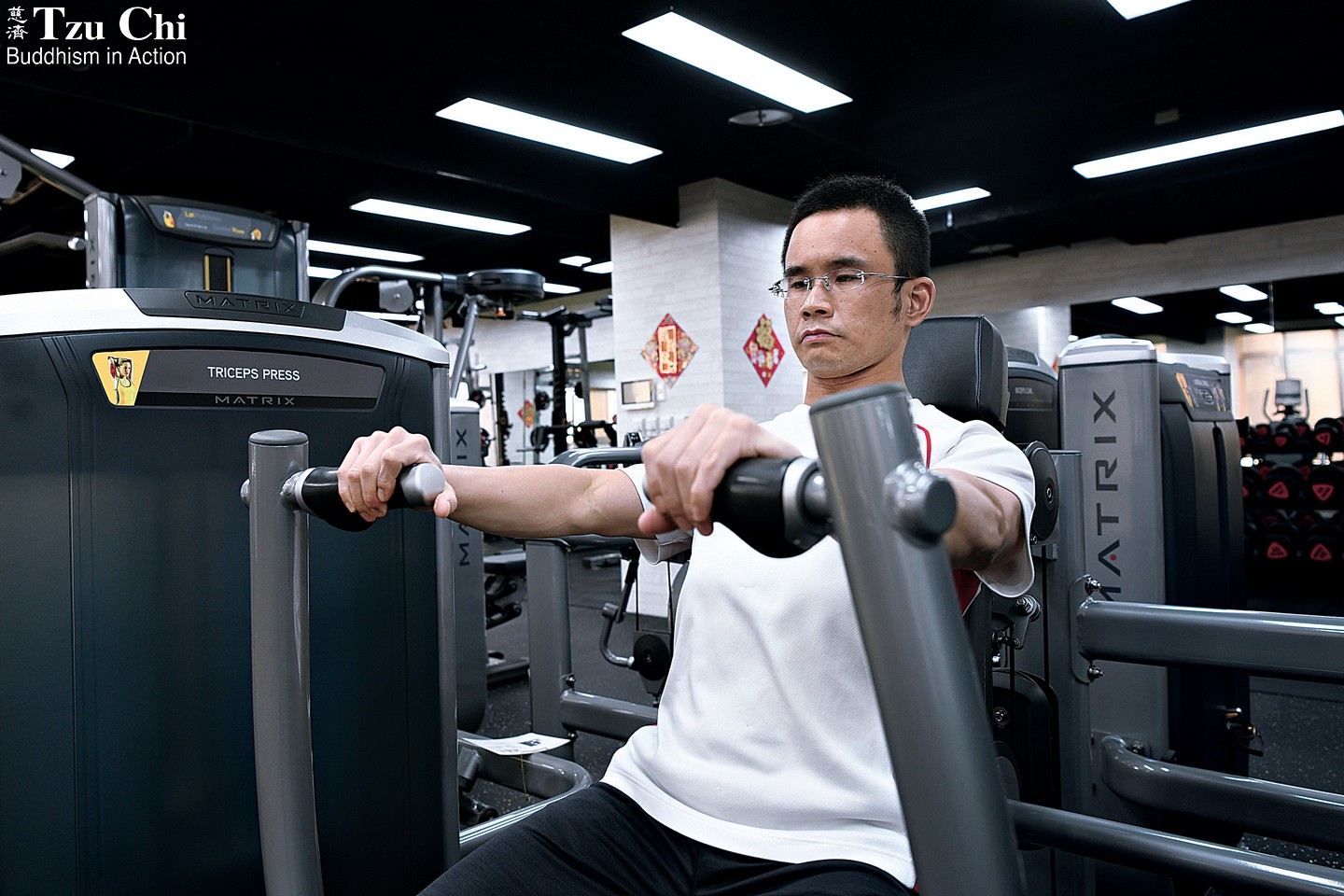
Getting fit
Chiayi Tzu Chi Clinic is located in Chiayi County, which, along with neighboring Yulin County, is home to a large population of older people. The clinic focuses their services mostly on seniors in these areas. However, since prevention is better than cure, everyone is welcome to visit the clinic to have their physical fitness assessed before they decide whether or not to train at the center. “Anyone who feels they have the need to train and who can still walk into the clinic is welcome,” said Director Chou. “In my opinion, everyone should train.”
After a patient’s condition is assessed at the clinic, the doctor will discuss with the instructor how to tailor the training prescription. Some patients have chronic illness or have had their knee joints replaced—all such circumstances need to be taken into consideration when writing the prescription. The instructor will also make adjustments to his curriculum in accordance with the patient’s performance during a training session.
Chou said that some people who have had hip or knee joint replacement surgery believe that they should avoid pressure on their joints, but what they don’t know is that only when the muscles surrounding the joints are strong enough will they offer good protection to their joints. He explained that for these patients, he generally asks the coach to pay special attention to training their lower limbs, by way of exercises such as squats—deeper squats than usual.
That being said, there are people who may be unfit for strength training. They include those who have recently experienced chest pain or tightness or have even passed out. They should have their hearts checked first if they want to try strength training. People who easily get short of breath are advised to find out if they have any heart problems too. Those who have swollen ankles should also take extra caution, because it could be a sign of kidney or liver disease.
Dai Yi-fang (戴一芳), 65, woke early one morning more than ten years ago to a sudden stiffness in his right shoulder, which was followed by soreness, pain, and numbness. It was so bad that he couldn’t even button up his clothes, but he didn’t think much of it at the time. Later, he had a traffic accident and was diagnosed with a severe case of osteoporosis. When his condition was at its worst, he lost a lot of strength in his legs, became winded just from walking for five or six minutes, and when he sat, his tailbone hurt awfully. His weight plummeted from 40 kilograms (88 pounds) to 30. He began coming to the fitness center at Chiayi Tzu Chi Clinic half a year ago, at his daughter’s encouragement, to strength train with an instructor.
“Sit on the chair,” Wang Hao-yu (王皓譽), an instructor at the center, said to Dai during a training session. “Now stand up, and slowly crouch down to the height of the chair. Put your weight on your thighs; use the strength of your thighs to support your body.” The instructor explained that because Dai’s bones offer poor support, excessive load-bearing should be avoided. He should also avoid twisting his spine right or left or bending forward or backward. “Get the feel of your muscles first,” he said. “Learn how to use them to control your body.”
Wang said that he often comes across people in the fitness center suffering from sarcopenia or backaches. Nearly nine out of ten such people don’t exercise regularly. Most of them find that walking or other normal daily activities are more strenuous than they used to be. Some patients come to the center because they’ve had surgery and are taking their doctors’ advice to train to increase their strength and endurance. He explained that instructors at the center design courses according to each individual’s physical condition, so people who have never taken fitness courses need not worry that they can’t handle the training regimen. “We’ll start with the basics,” he said.
Dai Yi-fang, the man who began training at the center at his daughter’s encouragement, said that whenever he saw other people coming to the center in wheelchairs or with the aid of crutches, he felt blessed because he could still walk on his own. “My legs have become much stronger now,” he said. “I can walk for two hours straight now without problems, or rise from a sitting position without having to use my hands for support. I’ll keep training. I want to go mountain climbing one day.”
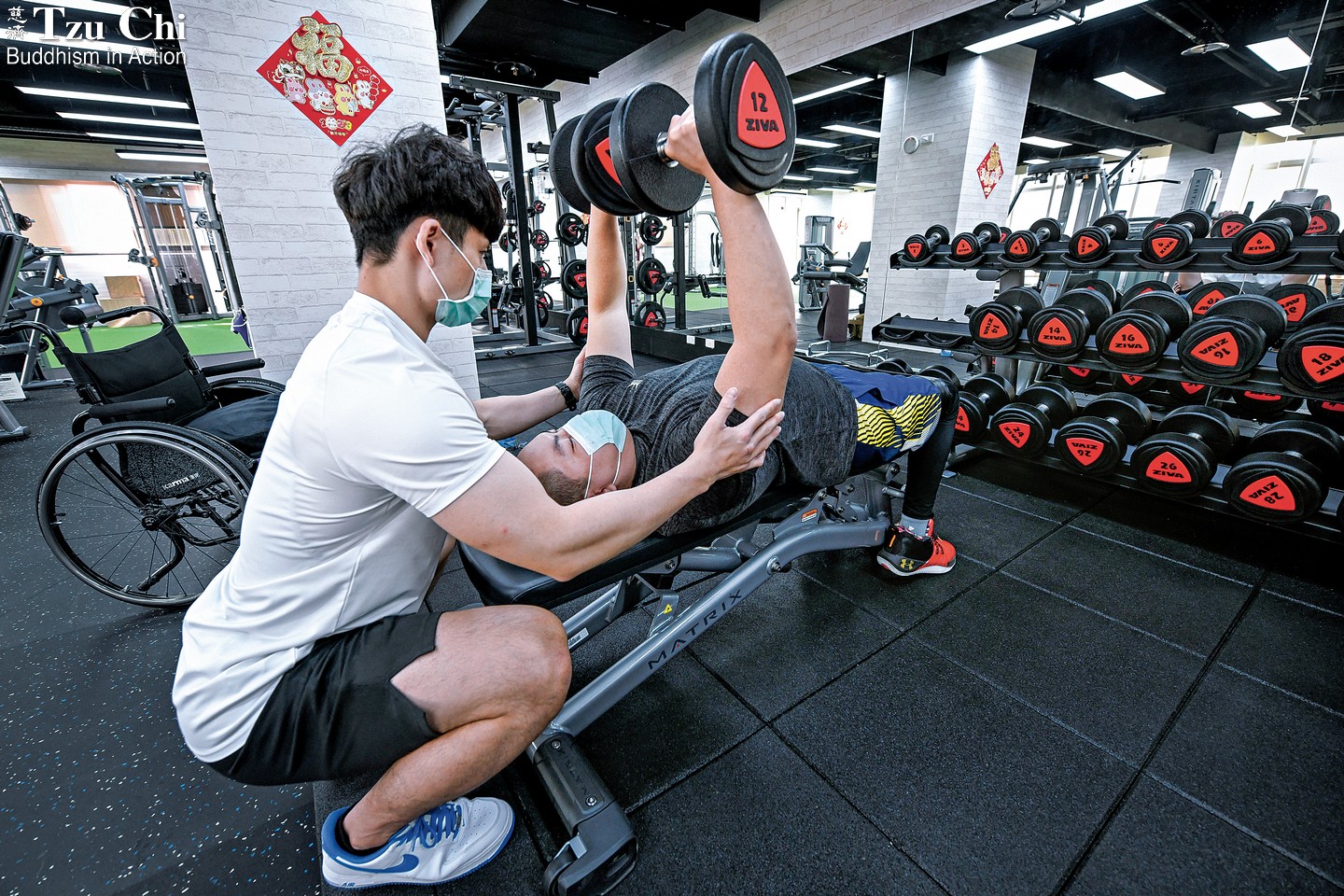
Xiao Kao-xiang (right) was paralyzed from the bottom of his chest down due to a traffic accident. He undergoes regular physiotherapy sessions at a hospital, and trains at the Anti-Aging Fitness Center to further strengthen his upper limbs.
A sense of accomplishment
Xiao Kai-xiang (蕭愷翔) is 28 years old this year. He was in a traffic accident eight years ago, injuring his thoracic spine, leaving him paralyzed from the bottom of his chest on down. He relies on a wheelchair to get around. After his injury, he started undergoing physiotherapy at a hospital. He also did dumbbell and barbell workouts at home. When he felt that he was up to more rigorous exercises, his mother started taking him to the Anti-Aging Fitness Center.
“Lie down flat,” said instructor Wang to Xiao. “Chest out. Brace your core. Hold up the dumbbells with your arms straight. Lower the dumbbells until they are at a 45-degree angle.” Xiao’s upper limbs were the only body parts he could still move, so Wang focused on training and strengthening his chest, back, arms, and the stability of his body.
Wang explained that a fitness trainer is different from a physical therapist. A trainer mainly focuses on providing fitness training with an eye to preventing injury. They instruct people on how to maintain correct postures when exercising and other related know-how. A trainer can’t treat an injury or engage in any medical services. A physical therapist, on the other hand, is primarily dedicated to treatment and physiotherapy following an injury. He suggested that people who have just sustained an injury or are suffering from acute pains go to the doctor for a checkup or treatment first before coming to the fitness center.
Xiao Kai-xiang, the paraplegic, said that his coach always gives him very detailed instructions and takes a lot of care to protect him from injury whenever he trains at the center. His physiotherapy sessions at the hospital can prevent a decline in his physical functions, but the strength training at the fitness center can enhance the effects of the physiotherapy. “The nerve injury I sustained in the traffic accident caused me to lose feelings in my back muscles,” said Xiao. “But now I can feel my back muscles working again when they are engaged. I used to need to sit in chairs with backs, but now I can sit on backless chairs too.”
“I’m so happy every time someone training at our center tells me his or her physical condition has greatly improved,” said Wang. Wang used to work in a commercial gym, where most of his clients were young, energetic, and relatively fit. Now, at the fitness center, the majority of people he works with are older, weaker, and sometimes even sick. The level of challenge he faces at work has therefore greatly increased. Despite that, he likes the sense of accomplishment he gets at his current job. “People might walk into the center with difficulty when they first come,” he said, “but I hope that with our help they will one day regain their physical functions and live happier, more carefree lives.”
Wang mentioned someone he coaches at the center who is in his 40s. He has dwarfism and has been diagnosed with early-onset Parkinson’s disease. Despite that, his spirits and physical condition improved after he started training at the center. He said that he feels happiest when he is at the center, where someone is beside him when he works out and with whom he can chat. “Any positive feedback from a student is motivating and helps keep me going,” said the trainer.
From nine to 99 years of age
Director Chou said that many people mistakenly believe that weight training can easily cause injuries. But according to statistics from the United States, the chance of weight training resulting in severe injuries is about the same as playing badminton or tennis. A higher likelihood of serious injuries comes from team sports, such as basketball, rugby, and soccer. Most of the severe injuries that do occur during strength or weight training arise from one accidentally dropping a dumbbell on oneself instead of from other causes. Weight training is very safe if you maintain correct movements and postures and avoid overstraining yourself, and, even better, work out with supervision from a professional trainer.
Chou pointed out that young people nowadays spend a lot of time in front of their computers or on their handheld devices, and thus lead a relatively sedentary lifestyle. Even though they might not be victims of sarcopenia yet—which is more common among older people—some of them might already be suffering from muscle weakness. He suggested that they start strength training in moderation. “I have a vision, a vision where everyone from nine to 99 years old does strength training,” said Chou.
Chou added that even though strength training is good for all ages, the elderly can especially benefit from it. Functional impairments are something they might have to face sooner than later, and strength training can help them maintain independence and delay the need for care. Many older people might look healthy, have no difficulty walking, taking care of themselves, or gardening. But once they come down with a severe illness, they might become bedridden for the rest of their lives. This might be because they haven’t worked to build their muscles. On the other hand, if they strength train regularly and build a strong body, their good physical condition might come in handy on a rainy day. Even if they can’t return to what they were like before they fell ill, there is a good chance for them to have some sort of independence.
“We don’t want to just live, but live with quality,” said Director Chou. “We want to live the kind of life we want to lead. The best answer to that is strength training.” It takes time to build up our muscles, he added. “You need to give yourself at least half a year. But as long as you are willing to stick to it under the guidance of your trainer, you are sure to see the results of your efforts.”



